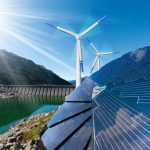Despite pigheaded intransigence at the highest levels of its national government, the renewable energy revolution is coming to Australia in a big way. And why not? Enough sunlight hits what Bill Bryson calls “a sunburned country” every day to meet all of humanity’s energy needs for a year. All it has to do is figure out how to harvest and distribute all that energy. (It could begin by replacing its national leaders with people who possess actual functioning brains, but the same can be said for many nations around the world.)
The state of New South Wales, home to Sydney and its iconic opera house, has designated a large area north and west of that city as the site for 3 GW of new renewable energy systems. Called the Central West hub, it will be the first step in a planned 17.7 GW renewable energy system for NSW. Other renewable energy zones in the New England and South West area of the state will be developed to complete the plan, which government sources say will attract $14 billion in private investment and create 2,000 jobs.
According to PV Tech, the NSW climate plan released this year sets a target of 126 GWh solar energy by 2024, which is more than double the existing 55 GWh goal. Local regulators say 75% of the electricity in the state could come from renewables as soon as 2025, “provided action is taken against the imbalances triggered by increasing uptake of variable capacity.”
Energy Storage Is The Key
The problem is not creating electricity from renewables. The problem is distributing it efficiently. Australia is vast in size, with enormous distances between its major cities. Its transmission infrastructure is outdated and frail in many cases — sort of like Puerto Rico but multiplied by a factor of 10,000.
Energy storage will be key to the transition to renewable energy. Wood Mackenzie released a study in May which warns that 67 GW of new renewable energy is at risk because of transmission constraints. Now Siemens and AES have formed a joint venture known as Fluence that wants to install two 250 MW/125 MWh battery storage facilities in Victoria and New South Wales to act as a “virtual transmission line” between the two states, according to a report by Recharge News. In a filing with the Australian Energy Market Operator, Fluence says it could complete both projects in 14 months once approval is granted.
Fluence says the effect of the batteries on the network would be similar to “widening a highway instantaneously to accommodate surges in traffic” and eliminate the the need for costly new transmission infrastructure. Neoen, the owner/operator of the Hornsdale facility, is also proposing a 600 MW battery facility near Melbourne. So bring on the wind and solar energy. Private industry and local governments are ready, willing, and able to do what the national government refuses to do — slash carbon emissions so we can all enjoy our tiny blue marble on the far edge of the Milky way a little while longer.





